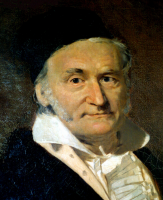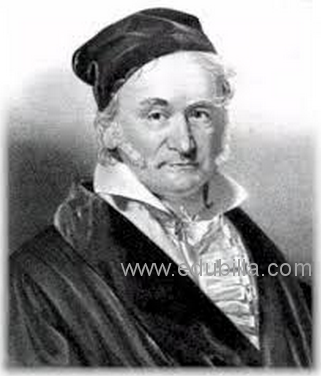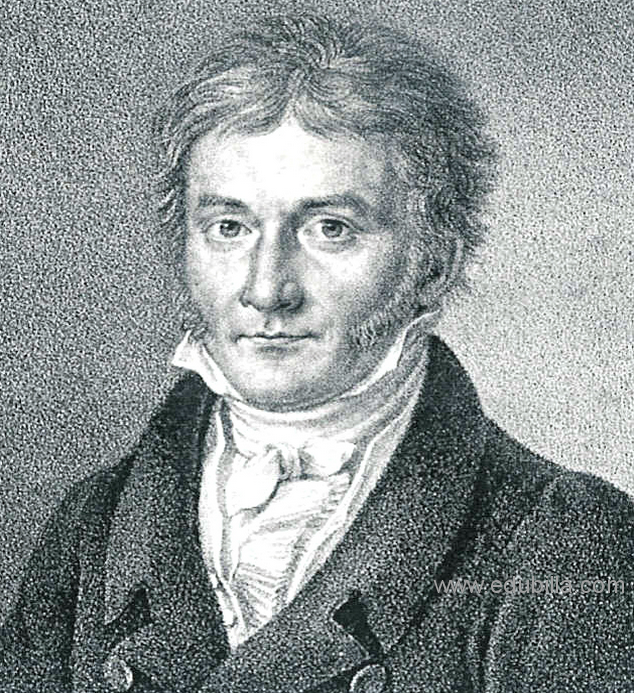










Johann Carl Friedrich Gauss was a German mathematician who contributed significantly to many fields, including number theory, algebra, statistics, analysis, differential geometry, geodesy, geophysics, electrostatics, astronomy, Matrix theory, and optics.
Sometimes referred to as the Princeps mathematicorum and "greatest mathematician since antiquity", Gauss had a remarkable influence in many fields of mathematics and science and is ranked as one of history's most influential mathematicians.
Early Life
Carl Friedrich Gauss was born on 30 April 1777 in Brunswick (Braunschweig), in the Duchy of Brunswick-Wolfenbüttel (now part of Lower Saxony, Germany), as the son of poor working-class parents.His mother was illiterate and never recorded the date of his birth, remembering only that he had been born on a Wednesday, eight days before the Feast of the Ascension, which itself occurs 40 days after Easter. Gauss would later solve this puzzle about his birthdate in the context of finding the date of Easter, deriving methods to compute the date in both past and future years.He was christened and confirmed in a church near the school he attended as a child.
Gauss was a child prodigy. There are many anecdotes about his precocity while a toddler, and he made his first ground-breaking mathematical discoveries while still a teenager. He completed Disquisitiones Arithmeticae, his magnum opus, in 1798 at the age of 21, though it was not published until 1801. This work was fundamental in consolidating number theory as a discipline and has shaped the field to the present day.
Gauss's intellectual abilities attracted the attention of the Duke of Brunswick,who sent him to the Collegium Carolinum (now Braunschweig University of Technology), which he attended from 1792 to 1795, and to the University of Göttingen from 1795 to 1798. While at university, Gauss independently rediscovered several important theorems;his breakthrough occurred in 1796 when he showed that any regular polygon with a number of sides which is a Fermat prime (and, consequently, those polygons with any number of sides which is the product of distinct Fermat primes and a power of 2) can be constructed by compass and straightedge. This was a major discovery in an important field of mathematics; construction problems had occupied mathematicians since the days of the Ancient Greeks, and the discovery ultimately led Gauss to choose mathematics instead of philology as a career. Gauss was so pleased by this result that he requested that a regular heptadecagon be inscribed on his tombstone. The stonemason declined, stating that the difficult construction would essentially look like a circle.
The year 1796 was most productive for both Gauss and number theory. He discovered a construction of the heptadecagon on 30 March.He further advanced modular arithmetic, greatly simplifying manipulations in number theory.On 8 April he became the first to prove the quadratic reciprocity law. This remarkably general law allows mathematicians to determine the solvability of any quadratic equation in modular arithmetic. The prime number theorem, conjectured on 31 May, gives a good understanding of how the prime numbers are distributed among the integers.
Gauss also discovered that every positive integer is representable as a sum of at most three triangular numbers on 10 July and then jotted down in his diary the note: "??????! num = ? + ? + ?". On October 1 he published a result on the number of solutions of polynomials with coefficients in finite fields, which 150 years later led to the Weil conjectures.
In his 1799 doctorate in absentia, A new proof of the theorem that every integral rational algebraic function of one variable can be resolved into real factors of the first or second degree, Gauss proved the fundamental theorem of algebra which states that every non-constant single-variable polynomial with complex coefficients has at least one complex root. Mathematicians including Jean le Rond d'Alembert had produced false proofs before him, and Gauss's dissertation contains a critique of d'Alembert's work. Ironically, by today's standard, Gauss's own attempt is not acceptable, owing to implicit use of the Jordan curve theorem. However, he subsequently produced three other proofs, the last one in 1849 being generally rigorous. His attempts clarified the concept of complex numbers considerably along the way.
Gauss also made important contributions to number theory with his 1801 book Disquisitiones Arithmeticae (Latin, Arithmetical Investigations), which, among other things, introduced the symbol ? for congruence and used it in a clean presentation of modular arithmetic, contained the first two proofs of the law of quadratic reciprocity, developed the theories of binary and ternary quadratic forms, stated the class number problem for them, and showed that a regular heptadecagon (17-sided polygon) can be constructed with straightedge and compass.
In that same year, Italian astronomer Giuseppe Piazzi discovered the dwarf planet Ceres. Piazzi could only track Ceres for somewhat more than a month, following it for three degrees across the night sky. Then it disappeared temporarily behind the glare of the Sun. Several months later, when Ceres should have reappeared, Piazzi could not locate it: the mathematical tools of the time were not able to extrapolate a position from such a scant amount of data—three degrees represent less than 1% of the total orbit.
Gauss, who was 24 at the time, heard about the problem and tackled it. After three months of intense work, he predicted a position for Ceres in December 1801—just about a year after its first sighting—and this turned out to be accurate within a half-degree when it was rediscovered by Franz Xaver von Zach on 31 December at Gotha, and one day later by Heinrich Olbers in Bremen.
Gauss's method involved determining a conic section in space, given one focus (the Sun) and the conic's intersection with three given lines (lines of sight from the Earth, which is itself moving on an ellipse, to the planet) and given the time it takes the planet to traverse the arcs determined by these lines (from which the lengths of the arcs can be calculated by Kepler's Second Law). This problem leads to an equation of the eighth degree, of which one solution, the Earth's orbit, is known. The solution sought is then separated from the remaining six based on physical conditions. In this work Gauss used comprehensive approximation methods which he created for that purpose.
One such method was the fast Fourier transform. While this method is traditionally attributed to a 1965 paper by J. W. Cooley and J. W. Tukey, Gauss developed it as a trigonometric interpolation method. His paper, Theoria Interpolationis Methodo Nova Tractata, was only published posthumously in Volume 3 of his collected works. This paper predates the first presentation by Joseph Fourier on the subject in 1807.
Zach noted that "without the intelligent work and calculations of Doctor Gauss we might not have found Ceres again". Though Gauss had up to that point been financially supported by his stipend from the Duke, he doubted the security of this arrangement, and also did not believe pure mathematics to be important enough to deserve support. Thus he sought a position in astronomy, and in 1807 was appointed Professor of Astronomy and Director of the astronomical observatory in Göttingen, a post he held for the remainder of his life.
The discovery of Ceres led Gauss to his work on a theory of the motion of planetoids disturbed by large planets, eventually published in 1809 as Theoria motus corporum coelestium in sectionibus conicis solem ambientum (Theory of motion of the celestial bodies moving in conic sections around the Sun). In the process, he so streamlined the cumbersome mathematics of 18th century orbital prediction that his work remains a cornerstone of astronomical computation.It introduced the Gaussian gravitational constant, and contained an influential treatment of the method of least squares, a procedure used in all sciences to this day to minimize the impact of measurement error. Gauss proved the method under the assumption of normally distributed errors. The method had been described earlier by Adrien-Marie Legendre in 1805, but Gauss claimed that he had been using it since 1795.
In 1818 Gauss, putting his calculation skills to practical use, carried out a geodesic survey of the Kingdom of Hanover, linking up with previous Danish surveys. To aid the survey, Gauss invented the heliotrope, an instrument that uses a mirror to reflect sunlight over great distances, to measure positions.
Gauss also claimed to have discovered the possibility of non-Euclidean geometries but never published it. This discovery was a major paradigm shift in mathematics, as it freed mathematicians from the mistaken belief that Euclid's axioms were the only way to make geometry consistent and non-contradictory. Research on these geometries led to, among other things, Einstein's theory of general relativity, which describes the universe as non-Euclidean. His friend Farkas Wolfgang Bolyai with whom Gauss had sworn "brotherhood and the banner of truth" as a student, had tried in vain for many years to prove the parallel postulate from Euclid's other axioms of geometry. Bolyai's son, János Bolyai, discovered non-Euclidean geometry in 1829; his work was published in 1832. After seeing it, Gauss wrote to Farkas Bolyai: "To praise it would amount to praising myself. For the entire content of the work ... coincides almost exactly with my own meditations which have occupied my mind for the past thirty or thirty-five years."
This unproved statement put a strain on his relationship with János Bolyai (who thought that Gauss was "stealing" his idea), but it is now generally taken at face value.Letters from Gauss years before 1829 reveal him obscurely discussing the problem of parallel lines. Waldo Dunnington, a biographer of Gauss, argues in Gauss, Titan of Science that Gauss was in fact in full possession of non-Euclidean geometry long before it was published by János Bolyai, but that he refused to publish any of it because of his fear of controversy.
The geodetic survey of Hanover, which required Gauss to spend summers traveling on horseback for a decade,fueled Gauss's interest in differential geometry, a field of mathematics dealing with curves and surfaces. Among other things he came up with the notion of Gaussian curvature. This led in 1828 to an important theorem, the Theorema Egregium (remarkable theorem), establishing an important property of the notion of curvature. Informally, the theorem says that the curvature of a surface can be determined entirely by measuring angles and distances on the surface. That is, curvature does not depend on how the surface might be embedded in 3-dimensional space or 2-dimensional space.
In 1821, he was made a foreign member of the Royal Swedish Academy of Sciences.
In 1831 Gauss developed a fruitful collaboration with the physics professor Wilhelm Weber, leading to new knowledge in magnetism (including finding a representation for the unit of magnetism in terms of mass, charge, and time) and the discovery of Kirchhoff's circuit laws in electricity. It was during this time that he formulated his namesake law. They constructed the first electromechanical telegraph in 1833, which connected the observatory with the institute for physics in Göttingen. Gauss ordered a magnetic observatory to be built in the garden of the observatory, and with Weber founded the "Magnetischer Verein" (magnetic club in German), which supported measurements of Earth's magnetic field in many regions of the world. He developed a method of measuring the horizontal intensity of the magnetic field which was in use well into the second half of the 20th century, and worked out the mathematical theory for separating the inner and outer (magnetospheric) sources of Earth's magnetic field.
In 1840, Gauss published his influential Dioptrische Untersuchungen,in which he gave the first systematic analysis on the formation of images under a paraxial approximation (Gaussian optics).Among his results, Gauss showed that under a paraxial approximation an optical system can be characterized by its cardinal points and he derived the Gaussian lens formula.
In 1854, Gauss selected the topic for Bernhard Riemann's Habilitationvortrag, Über die Hypothesen, welche der Geometrie zu Grunde liegen.On the way home from Riemann's lecture, Weber reported that Gauss was full of praise and excitement.
Death
Gauss died in Göttingen, in the Kingdom of Hanover (now part of Lower Saxony, Germany) on 23 February 1855 and is interred in the Albanifriedhof cemetery there. Two individuals gave eulogies at his funeral: Gauss's son-in-law Heinrich Ewald and Wolfgang Sartorius von Waltershausen, who was Gauss's close friend and biographer. His brain was preserved and was studied by Rudolf Wagner who found its mass to be 1,492 grams (slightly above average) and the cerebral area equal to 219,588 square millimeters (340.362 square inches). Highly developed convolutions were also found, which in the early 20th century was suggested as the explanation of his genius.

